January 23, 2005
IMBB11 - Beans
For my first entry in Is My Blog Burning? I was thrilled to lean that the theme would be "beans." This is a revelation that would surprise my mother -- as a child I loathed beans in all forms, and now I love them in just about all forms. Check out the other IMBB11 entries here.
Here in Northern California, the weather has been cold and rainy, so it was obvious to me that a Cassoulet was in order. The idea of the oven and stove being on for the better part of two days was just too tempting to resist. Cassoulet can be made in under a day, if you start fairly early in the morning, and won't be eating until late. But it's more usual to prepare the day before, and assemble and cook on the second day.
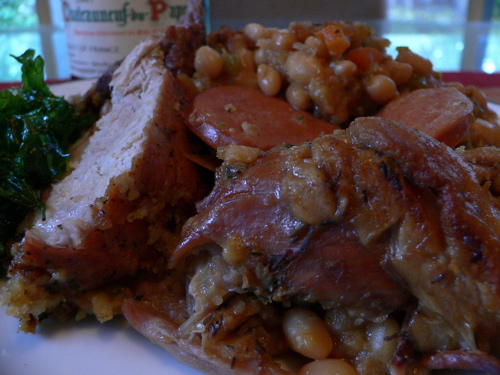
Nothing better on a cold day
A Cassoulet is a French bean and meat casserole that involves a whole range of parts. Like any traditional dish, there are heated arguments about what does or does not go into a "proper" Cassoulet. I decided to make the most common one that I usually make, and include more or less the traditional ingredients.
The "recipe" (more like a general plan of attack) is as follows:
4 C dried small white beans
1 qt demiglace
2-3 lbs of meats
2 C mirpoix
3 C fresh breadcrumbs
- Soak beans overnight
- Drain beans, place in pot with fresh water, simmer until tender, 45-60 mins, reserve cooking liquid.
- Sautee mirpoix
- Layer beans, mirpoix, meats into large casserole. Salt and pepper as you go.
- Pour demiglace and/or reserved bean cooking liquid over casserole until just covering the beans
- 350 oven for 2 hours, uncovered
- Layer bread crumbs on top of casserole and return to oven for another hour
Lamb and pork are pretty common. Confit of duck or goose also. Some say to never include confit, others require it. Some add foie gras to the cassoulet. I used what looked good in the shops.
- one whole duck
- one lamb loin (trimmed from a rack of lamb that was around 1.75 lbs)
- one 4 inch wide "country pork rib" (this is a cut of pork that's really more like the pork belly with some ribs attached). Some people use thick cut bacon, or pork loin and bacon.
- one garlic sausage
The first task upon arriving home from the store was to make a demi/stock from some of the meats. Not everyone uses a stock or demi in making a cassoulet, but I personally love the rich flavor that it imparts. I used the carcass, head, feet, and wings trimmed from the duck, along with the ribs from the rack of lamb, and the ribs trimmed from the pork rib. This made a three meat stock. Trim from the mirpoix was the vegetables, and two teaspoonfuls of tomato paste was cooked down at the end. I cooked the stock for three hours, strained it, and re-cooked it with some brown roux to form the demi.
The duck yielded:
- legs and thighs for a confit
- carcass for the stock
- fat and skin, to be rendered down for fat and used to make the confit and also sautee various items in the cassoulet. The cracklings from the rendering make either a nice snack, or can be used on top of a salad much like one would use bacon.
- two wonderful duck breasts, saved for another meal
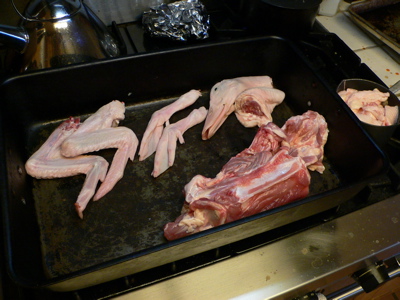
Be sure to use all of the duck
Okay, is the duck head and the little pot of skin and fat on the right already too much information and meat for you? You might want to check out my vegetarian cassoulet recipe then.
Still with me? Good. Let's move on to the next day, so we can see all of the parts together.
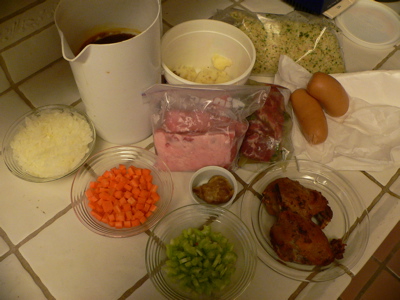
Mis en Place for the Cassoulet
Diagonally left to right and front to back we have:
- mirpoix (onion, carrot, celery)
- 1 quart of three meat demi
- trimmed pork (center)
- roasted garlic puree (1 head wrapped in foil, 350 for an hour)
- confit duck thighs, broiled to crisp the skin
- container of duck fat (from the confit)
- lamb loin
- two garlic sausages (I only used one)
- bread crumbs with parsley, salt, and pepper.
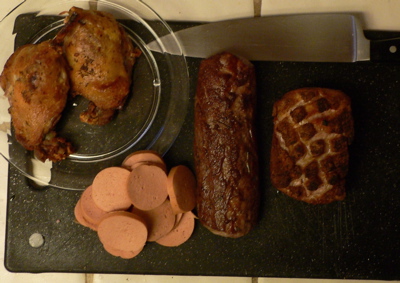
The meats, ready for assembly
Here's how I prepared each of the meats -- left to right, 8 inch chef's knife for reference.
The duck confit is made by coating the legs/thighs from the duck with salt, pepper, bay leaf (1), and allspice (6 whole, crushed). The duck is allowed to sit for a few hours (overnight would have been better). It is then wiped off and placed in a small pot of duck fat, and slowly simmered until tender. The duck is then cooled, and stored overnight (or until needed) in the fridge, covered in the duck fat. To use, the duck is removed from the fat (and excess is again wiped off) and placed under the boiler, skin side up, until crispy.
The garlic sausage was bought at a store and sliced into rounds. Whew! After the duck, this seems like a smart move, huh?
The lamb loin was trimmed from the bones, all fat and silver skin were removed. The lamb sat overnight in a mixture of olive oil, salt, pepper, and rosemary. A quick sear on all sides.
The pork simply had the top layer of fat scored, coated with salt and pepper, and once again seared on all sides.
You can either leave the large pieces of meat intact, or cut them into smaller pieces. The large pieces allow you to (in theory) fish the meat out of the final dish and portion it as needed. Going with smaller pieces would allow guests to just scoop out a spoonful and be surprised with what meat they got. Both methods work fine, but if the final beans end up very thick it can be difficult to fish out the very tender meat without it falling apart. I chose to keep the meats in large pieces this time.
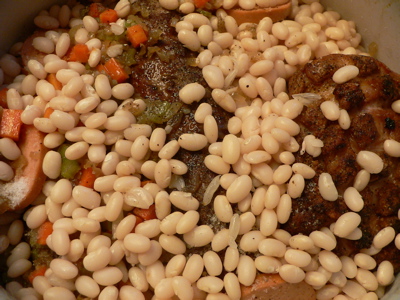
Everything in one pot
After the meats were ready, the mirpoix was sauteed in duck fat, and then mixed with the roasted garlic. The beans (small white beans, 4 cups dry, soaked overnight) were drained and cooked in simmering water until just slightly tender (about an hour). The beans were then drained (with the cooking liquid reserved).
Finally! Time to assemble and really begin to cook this thing! Layers of beans, cooked mirpoix, salt, pepper, and the meats were placed into a large round dish.
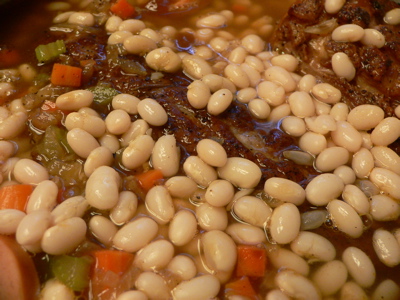
Ready for the oven
The demi and a bit of the reserved bean cooking liquid were poured over the top until the beans were almost covered. With that, the cassoulet is ready for a 350 oven. You want to cook the cassoulet until it is bubbly and hot throughout, and the stock has started to thicken. This will take probably two hours, maybe more depending upon the temperature of all of the ingredients when they go in. If you think that the cassoulet is drying out rather than just thickening, you can add additional demi, reserved bean liquid, both, or just plain water.
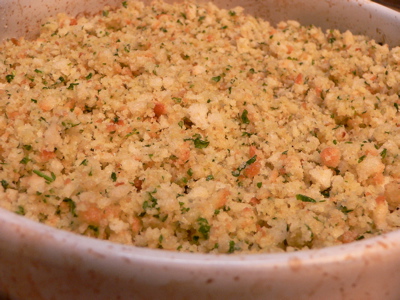
What a crumby job
Once the stock has thickened a bit, a layer of bread crumbs mixed with melted duck fat is spread over the top. Cooking continues, and the stock is allowed to bubble up, thickend, over the top of the crumbs. Traditionally, the crust is from time to time pushed down to break it and repeatedly allowed to form. This is probably another hour. You can quicken it a bit by raising the heat of the oven to 375 or 400. This also assists in browning of the crust, but don't get too carried away -- if you see the cassoulet boiling furiously, you should drop the heat. You can let the cassoulet go for much longer total cooking time than three hours.
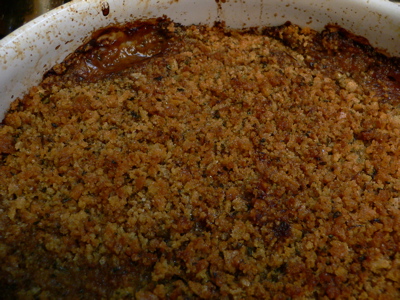
Ready to be served
Personally, I love the crumb part of the cassoulet -- so I use a pretty thick layer of crumbs. But you can experiment with what you feel is appropriate. If you have extra crumbs, save them for re-heating the next day. Ditto with any stock or bean liquid you didn't use.
Posted by dowdy at January 23, 2005 09:33 AM